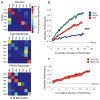Sensory-motor transformations for speech occur bilaterally
- PMID: 24429520
- PMCID: PMC4000028
- DOI: 10.1038/nature12935
Sensory-motor transformations for speech occur bilaterally
Abstract
Historically, the study of speech processing has emphasized a strong link between auditory perceptual input and motor production output. A kind of 'parity' is essential, as both perception- and production-based representations must form a unified interface to facilitate access to higher-order language processes such as syntax and semantics, believed to be computed in the dominant, typically left hemisphere. Although various theories have been proposed to unite perception and production, the underlying neural mechanisms are unclear. Early models of speech and language processing proposed that perceptual processing occurred in the left posterior superior temporal gyrus (Wernicke's area) and motor production processes occurred in the left inferior frontal gyrus (Broca's area). Sensory activity was proposed to link to production activity through connecting fibre tracts, forming the left lateralized speech sensory-motor system. Although recent evidence indicates that speech perception occurs bilaterally, prevailing models maintain that the speech sensory-motor system is left lateralized and facilitates the transformation from sensory-based auditory representations to motor-based production representations. However, evidence for the lateralized computation of sensory-motor speech transformations is indirect and primarily comes from stroke patients that have speech repetition deficits (conduction aphasia) and studies using covert speech and haemodynamic functional imaging. Whether the speech sensory-motor system is lateralized, like higher-order language processes, or bilateral, like speech perception, is controversial. Here we use direct neural recordings in subjects performing sensory-motor tasks involving overt speech production to show that sensory-motor transformations occur bilaterally. We demonstrate that electrodes over bilateral inferior frontal, inferior parietal, superior temporal, premotor and somatosensory cortices exhibit robust sensory-motor neural responses during both perception and production in an overt word-repetition task. Using a non-word transformation task, we show that bilateral sensory-motor responses can perform transformations between speech-perception- and speech-production-based representations. These results establish a bilateral sublexical speech sensory-motor system.
Conflict of interest statement
Figures




References
-
- Liberman AM, Cooper FS, Shankweiler DP, Studdert-Kennedy M. Perception of the Speech Code. Psychol Rev. 1967;74:431–461. - PubMed
-
- Liberman AM, Mattingly IG. The motor theory of speech perception revised. Cognition. 1985;21:1–36. - PubMed
-
- Halle M, Stevens KN. Speech recognition: A model and a program for research. IEEE Trans Information Theory. 1962;8:155–159.
-
- Halle M, Stevens KN. Analysis by synthesis. Proceedings of seminar on speech compression and processing. 1959;D7
-
- Berwick RC, Friederici AD, Chomsky N, Bolhuis JJ. Evolution, brain, and the nature of language. Trends Cogn Sci. 2013;17:89–98. - PubMed
Publication types
MeSH terms
Grants and funding
LinkOut - more resources
Full Text Sources
Other Literature Sources

